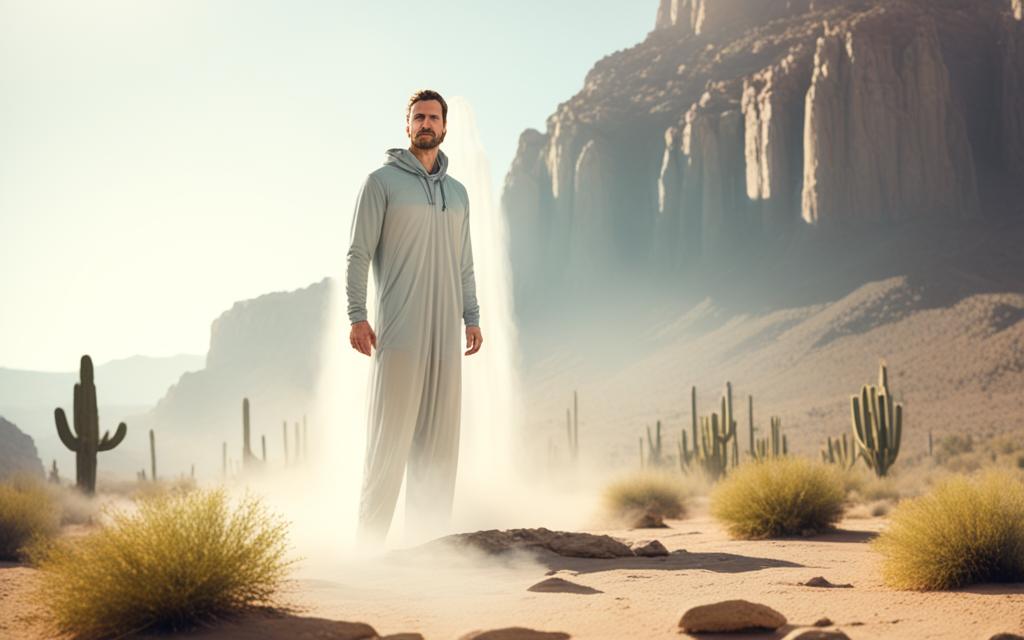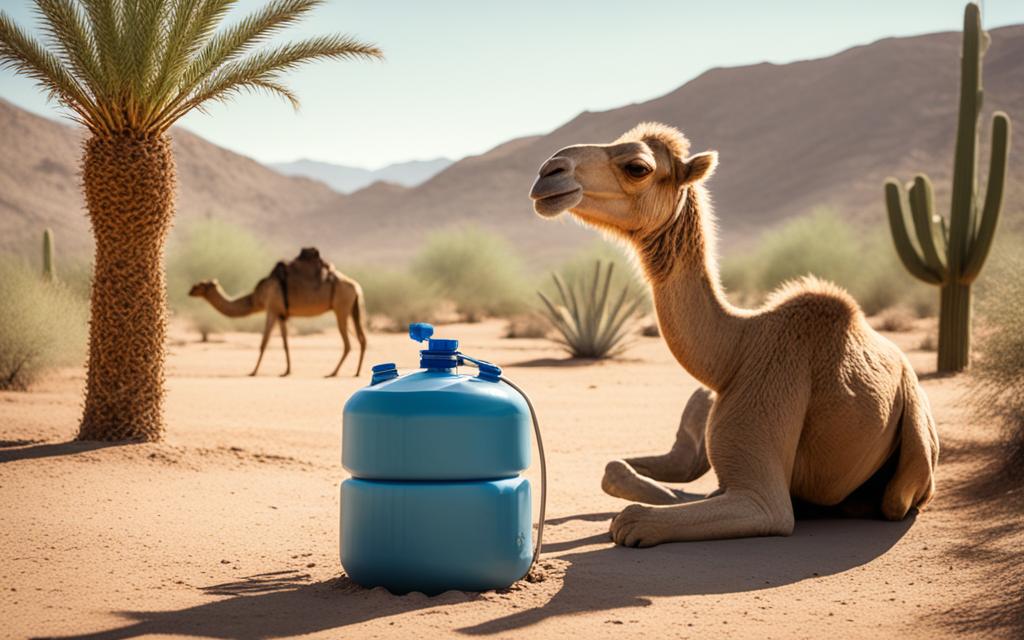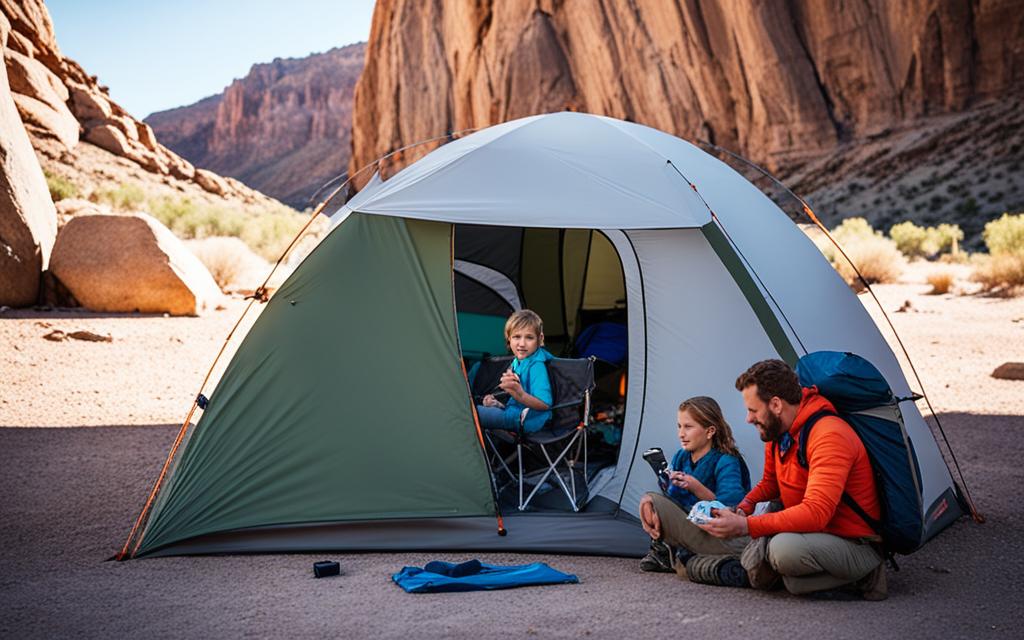Welcome to our comprehensive desert camping guide, where we’ll equip you with essential tips and techniques to conquer the challenges of camping in the hottest American deserts. From staying cool in extreme temperatures to ensuring your safety, we’ve got you covered on your desert adventure.
Picture yourself in the vast expanse of the American desert, surrounded by stunning landscapes and breathtaking sunsets. But before you embark on this remarkable journey, it’s important to be well-prepared to face the unique demands of desert camping.
With scorching temperatures and arid conditions, desert camping requires careful planning and the right gear. But don’t worry, we’ll guide you every step of the way to make your experience unforgettable.
Key Takeaways:
- Choose the right desert campsite based on water sources, shade availability, and safety considerations
- Pack essential gear including sun protection, hydration systems, and breathable clothing
- Stay cool in extreme desert heat by setting up shade structures and managing airflow
- Ensure proper hydration by identifying water sources and practicing effective hydration strategies
- Stay safe in the desert by taking precautions against wildlife encounters, flash floods, and navigation challenges
Choosing the Right Desert Campsite
When embarking on a desert camping adventure, finding the perfect campsite is the first crucial step. The right location can make all the difference in ensuring a comfortable and enjoyable experience. In this section, we will explore the key factors to consider when choosing a desert campsite.
Finding Proximity to Water Sources
Water is a precious resource in the desert, so it’s essential to camp near a reliable water source. Look for campsites that are close to natural springs, rivers, or lakes. This proximity will not only provide you with a convenient water source for drinking and cooking but also offer opportunities for swimming and other water-related activities.
Seeking Shade Availability
In the scorching heat of the desert, seeking shade becomes a necessity. Look for campsites that offer natural shade from trees, large rocks, or canyons. If natural shade is limited, consider bringing shade structures such as canopy tents or tarps to create your own sheltered areas.
Prioritizing Safety Considerations
Safety should be a top priority when selecting a desert campsite. Ensure you choose an area that is away from potential dangers, such as flash flood zones or unstable terrain. It’s also advisable to check for any local regulations or restrictions that might affect your camping plans.
Remember, the right campsite can provide you with not only a comfortable base but also breathtaking views and unforgettable experiences. Take your time to research and explore different options before making a decision.
To further enhance your understanding, here is a list of essential factors to consider when choosing a desert campsite:
- Proximity to water sources
- Availability of shade
- Safety considerations
- Accessibility and ease of reaching the site
- Potential wildlife encounters
By carefully considering these factors, you can ensure that your chosen desert campsite aligns with your preferences, needs, and safety requirements.
Next, we will delve into the essential gear you need to pack for a successful desert camping trip. From sun protection to hydration systems, we have got you covered to ensure a comfortable and safe experience in the desert.
Essential Gear for Desert Camping
When embarking on a desert camping adventure, having the right gear is essential for your comfort and safety. The scorching heat and harsh conditions of the American deserts require special equipment to ensure a successful trip. Here is a list of essential gear for desert camping:
Sun Protection
- Sunscreen: Protect your skin from harmful UV rays with a high SPF sunscreen.
- Sun hat: Shield your face and head from the intense desert sun with a wide-brimmed hat.
- Sunglasses: Invest in a pair of sunglasses with UV protection to safeguard your eyes.
Hydration Systems
- Water bottles: Carry reusable water bottles to stay hydrated throughout your journey.
- CamelBak: Consider using a hydration backpack like the CamelBak that allows easy access to water while keeping your hands free.
- Water purification tablets: Ensure you have a reliable method to purify water from natural sources.
Breathable Clothing
- Lightweight and loose-fitting clothes: Opt for breathable fabrics that allow air circulation and provide UV protection.
- Long-sleeve shirts and pants: Cover your skin to minimize sun exposure and protect against insect bites.
- Wide-brimmed hat: Keep your head cool and shielded from the sun with a ventilated hat.
Camping Gear for Desert Conditions
- Tent: Choose a tent with good ventilation and a rain fly to protect against unexpected weather changes.
- Sleeping bag: Use a lightweight sleeping bag that provides insulation without trapping excessive heat.
- Camp stove: Pack a portable stove for cooking meals and boiling water.
Remember, the desert environment can be unpredictable, so it’s crucial to be prepared with the right gear. By investing in these essential items, you’ll be equipped to handle the challenges and fully enjoy your desert camping experience.
Staying Cool in Extreme Desert Heat

In the scorching heat of the desert, keeping cool is not just a matter of comfort—it’s essential for your safety and well-being. By taking the right measures, you can prevent heat-related illnesses and enjoy your desert camping adventure to the fullest.
Here are some effective tips to help you stay cool in extreme desert heat:
Create Shade Structures
Shielding yourself from direct sunlight is crucial in staying cool in the desert. Set up shade structures using tarps, awnings, or pop-up canopies. Position them strategically to cover your tent, cooking area, and any communal spaces.
Remember to secure your shade structures properly to ensure they withstand strong desert winds.
Manage Airflow
Promoting airflow within your campsite can significantly reduce the heat. Arrange your tents, chairs, and other equipment in a way that allows for natural breezes to pass through.
Utilize portable fans or battery-operated misting systems to further enhance airflow and create a refreshing environment.
Adopt Cooling Techniques
There are several effective cooling techniques you can employ in the desert:
- Dampen Clothing: Wet a bandana or cloth and drape it around your neck or forehead to cool your body down.
- Evaporative Cooling: Hang a moist towel near your sleeping area. As the water evaporates, it will help reduce the surrounding temperature.
- Cooling Neck Wraps: Use special neck wraps that contain cooling gel or crystals. These wraps can provide long-lasting relief from the heat.
Remember to stay hydrated by drinking plenty of water, even if you’re not feeling thirsty. Dehydration can intensify the effects of heat and lead to heat exhaustion or heatstroke.
| Cooling Techniques | Effectiveness |
|---|---|
| Dampening Clothing | Effective for immediate relief |
| Evaporative Cooling | Provides continuous cooling as long as the towel remains moist |
| Cooling Neck Wraps | Offers prolonged cooling for several hours |
By implementing these strategies, you’ll be better equipped to stay cool and comfortable during your desert camping trip, allowing you to make the most of your adventure while keeping yourself safe.
Water and Hydration Strategies

When it comes to camping in the scorching heat of the American deserts, staying properly hydrated is absolutely vital. Dehydration can have serious health consequences and can quickly ruin your camping experience. In this section, we will discuss various water sources, water purification methods, and effective hydration strategies that will help you stay hydrated throughout your desert adventure.
Coping with Water Scarcity
Water scarcity is a common challenge in desert environments. It is essential to plan your water supply carefully and be mindful of your usage. Here are a few strategies to cope with water scarcity:
- Carry enough water: Start your camping trip with an ample supply of water. The general rule of thumb is to carry at least one gallon of water per person per day.
- Locate natural water sources: Research and identify natural water sources such as springs, creeks, or water holes in the area. These can serve as an important backup if your water supply runs low.
- Use water conservation techniques: Practice water conservation by taking quick showers, reusing rinse water for cleaning, and avoiding wastage.
Water Purification Methods
Ensuring the cleanliness of the water you consume is crucial to prevent water-borne illnesses. In the absence of clean water sources, consider the following water purification methods:
- Boiling: Boiling water is one of the most reliable and effective methods to kill harmful bacteria and viruses. Bring the water to a rolling boil for at least one minute, or three minutes if you are at higher altitudes.
- Water filtration systems: Portable water filters are available in the market and can effectively remove bacteria, protozoa, and other impurities from water sources. Look for filters with a pore size of less than 0.2 microns for optimal purification.
- Chemical treatments: Water purification tablets or drops containing chlorine dioxide can be used to disinfect and treat water. Follow the instructions provided by the manufacturer for the appropriate dosage and waiting time.
Effective Hydration Strategies
Simply having access to water is not enough; you also need to ensure you are hydrating properly. Here are some effective hydration strategies to consider:
- Drink frequently: Drink water at regular intervals, even if you don’t feel thirsty. Thirst is not always a reliable indicator of dehydration.
- Avoid excessive caffeine and alcohol: Both caffeine and alcohol can contribute to dehydration. Limit your consumption of these beverages to maintain optimal hydration levels.
- Consume electrolytes: In addition to water, replenish electrolytes lost through sweat by consuming sports drinks or electrolyte-enhanced water.
Remember, proper hydration is crucial for your overall well-being and survival in the harsh desert environment. By following these water and hydration strategies, you can stay safe, healthy, and fully enjoy your desert camping adventure.
| Water Sources | Pros | Cons |
|---|---|---|
| Natural Springs | Naturally filtered and refreshing | Availability may vary; requires prior research |
| Creeks/Rivers | Abundant source; can provide recreational activities | Water may require filtration or treatment before consumption |
| Water Holes | Can usually be found in desert wildlife areas | Might have stagnant water or be contaminated by wildlife |
Safety Tips for Desert Camping
When embarking on a desert camping adventure, prioritizing safety is of utmost importance. Here are some essential tips to ensure a secure and worry-free experience in the hottest American deserts:
1. Be Aware of Desert Wildlife: Desert ecosystems are home to various wildlife, including snakes and scorpions. To minimize encounters, avoid walking barefoot, wear closed-toe shoes, and shake out your shoes and clothing before putting them on. Additionally, store food securely to prevent attracting desert critters.
2. Prepare for Flash Floods: Despite the arid nature of deserts, flash floods can occur suddenly during intense rainstorms. Plan your campsite away from dry riverbeds and low-lying areas. Stay updated on weather forecasts and be vigilant for signs of heavy rainfall. If caught in a flash flood, seek higher ground immediately.
3. Navigate Carefully: Desert landscapes can be vast and disorienting. Always carry a map, compass, or GPS device to ensure you don’t get lost. Familiarize yourself with key landmarks or use natural formations as reference points. Inform someone about your planned route and expected return time.
4. Emergency Preparedness: Before setting out on your desert camping trip, prepare an emergency kit that includes first aid supplies, extra food and water, a flashlight, and a multi-tool. Familiarize yourself with basic first aid procedures and ensure your phone is fully charged. Additionally, inform someone trustworthy about your itinerary and contingency plans.




